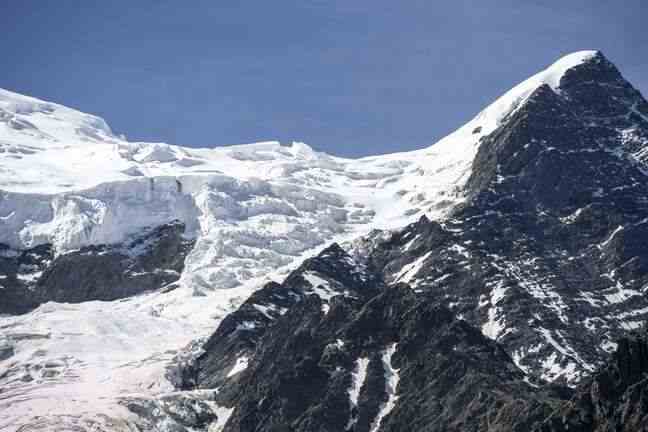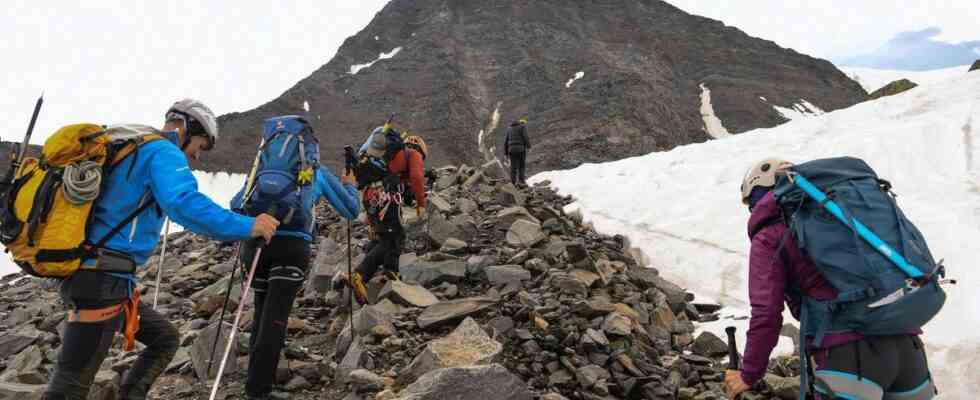“It was amazing, I didn’t recognize at all a route on the north face that I had climbed last summer. During his ten ascents in thirteen days of peaks over 3,600 m in altitude in the Ecrins massif (Hautes-Alpes), the Haute-Savoie mountaineer Charles Dubouloz often had to adapt this month to the consequences of the global warming on the mountain. “The state of the glaciers is so dry this summer that there are lots of crevasses everywhere,” he says. It’s amazing how everything has melted at breakneck speed. For example, it would have been poker to go through the Pilatte glacier, so we preferred to go around it by ridges, even if that lengthened the route by five hours. »
A caution shared by the two main guide companies supervising the ascent of Mont-Blanc from Chamonix and Saint-Gervais (Haute-Savoie). On July 13, they decided to “temporarily suspend and as a preventive measure” the Mont-Blanc courses by the royal road of Goûter, considered to be the most accessible. “In July, there is generally not the slightest landslide from 8 p.m. to 11 a.m. on this route, explains Dorian Labaeye, president of the National Union of Mountain Guides (SNGM). Last week, the guides noticed rockfalls at different times of the morning, which means that we can no longer predict the risks for the customers and for us. This decision specific to the guides is therefore the most reasonable, and race plans B or a refund are offered to customers. »
“There are always people who want to play Russian roulette”
Informed of this suspension, the authorities of Haute-Savoie immediately “strongly advised against” the mythical ascent by the Goûter corridor, located at more than 3,000 m altitude. Does this mean that there hasn’t been a single climber for nine days on this route? “No, because there are still a few foreign mountaineers,” continues Dorian Labaeye. But in two days, almost all the guides have stopped going to Mont-Blanc because ethically, we follow a local custom. The Goûter, Tête Rousse and Nid d’Aigle refuges remain open to the public until now (sleeping capacity of 214 people). And despite the numerous recommendations, at least a dozen mountaineers (including a guide on Thursday) still go to the emblematic Goûter refuge (120 places) every day.
This pushes the mayor of Saint-Gervais Jean-Marc Peillex to consider closing this refuge located at an altitude of 3,850 m, as he had already been able to do once in July 2015, faced with comparable risks of tragedy on this way. “There are always people who want to play Russian roulette, points out the chosen one. We are too often dealing here with urban mountaineers who tick off a date in July and who want to do Mont-Blanc that day whatever the cost, as if they were doing Space Mountain. To support his warnings, the mayor of Saint-Gervais relayed an impressive video on July 15, dating from the same morning, which shows a rock fall from the Aiguille du Goûter. On June 22, a 73-year-old mountaineer died in this same Goûter corridor, the victim of another landslide.
“There is no explosion of accidentology in France”
On site, the permafrost is currently disappearing due to the drought and the enormous heat, symbolized by an unprecedented temperature record of more than 10°C at the summit of Mont-Blanc in June. “The lack of snow leading to the risk of landslides has become regular since 2015, with all these episodes of heat waves, indicates Ludovic Ravanel, geomorphologist and research director at the CNRS. The big difference this summer is the earliness of the heat wave, which has never been so flagrant. The consequences are obviously much more problematic on the state of the glaciers when the heat wave episode occurs from the month of June rather than at the end of August. The glaciers in the Alps were even less damaged at the end of August 2021 than at the beginning of this month of July. »
In this extreme context, could a ban on access to glaciers and high mountains be envisaged in this summer which is as scorching as it is dangerous in places? “It remains one of the last territories of freedom and there is no explosion of accidentology in France, defends Ludovic Ravanel, stationed in Chamonix. It would therefore be completely absurd to prohibit the high mountains. The Tour Ronde and the Kuffner ridge at Mont Maudit are strongly discouraged by the guides but you can adapt as there are still plenty of routes to follow. Moreover, the guides do not particularly appreciate the ascent of Mont-Blanc, seen as it is massively borrowed. Guide companies seek to sell a high mountain experience more than the specific ascent of a peak. »
The fear of “the mountain put under a bell jar”
National Technical Director of the French Federation of Alpine and Mountain Clubs (FFCAM), Luc Thibal is in tune with this speech: “We are afraid, it is that we are putting the mountain under glass in a principle of extreme precaution, without this being based on objective reasons. This one fears in particular the weight of the images which could have had the deadly collapse of a part of the alpine glacier of Marmolada (11 victims), on July 3 in Italy.
“I understand the state of shock that this created as far as France, but it is a glacier that has been suffering for several years, he believes. In this particular summer, everyone is encouraged to take twice as many precautions before climbing somewhere. But global warming or not, there is always a risk in the mountains. And as we know that it would cost the state less to close the high mountains than to monitor certain portions, we fear a total ban on mountaineering. “Same story on the side of the guides, as summed up by Dorian Labaeye.
We try to dialogue as much as possible with the public authorities to avoid arriving at prefectural decrees prohibiting general access to the glaciers. An entire ecosystem would be plunged into difficulty. But we are never safe from a unilateral decision on their part. »
The precedent of February 1999 in Montroc
On this point, Jean-Marc Peillex wants to be reassuring for the world of mountaineering. “I will never prohibit access to the high mountains on a legal level. Because I would then no longer have the right to reopen, since there will always be a risk of falling rocks”. Dorian Labaeye evokes similar scenario in February 1999, when after an avalanche having killed 12 people in Montroc, the prefect of Haute-Savoie had issued an order to prohibit the practice of off-piste skiing, snowshoeing and mountaineering “outside the developed areas”. An unprecedented ban which had then constituted “a small trauma”, according to Dorian Labaeye.

Twenty-three years later, only the 250 to 300 ascents per day of Mont-Blanc via the Goûter route are therefore currently in jeopardy. And this, with the end of the high summer season brought forward by a big month compared to 2021. “God is angry and he did not realize that we were in July and not in August, ironically Jean-Marc Peillex . This is proof that the mountain is in charge. Those who have decided to climb Mont-Blanc at all costs today carry with them death in the backpack. »
Many guides now on vacation in August
The mayor of Saint-Gervais wants to put the economic and tourist loss caused by this situation into perspective, since he estimates that there are “between 50,000 and 100,000 daily visitors in the summer in the Chamonix valley”. He proposes to rethink the summer calendar of mountaineering, at the end of this landmark season. “We will have to adapt to nature and the ideal would be to start the season around mid-May, before taking a break in July-August and resuming in September. But there is a real divorce between the Mont-Blanc business and the real needs of the mountain to open earlier, because the Mont-Blanc company [société de remontées mécaniques] does not wish to shift its season in this way. »

The president of the SNGM Dorian Labaeye confirms: “It is a long-term job to get the Mont-Blanc tram to leave at 7 a.m. in June. It was already very difficult to bring forward the installation of this tramway to the beginning of July this year. Because of global warming, we’ve been encouraging our customers to come to the mountains earlier, from May-June, and educating them about flexibility. So much so that August has become a classic vacation month for many mountain guides. “20 years ago, it would have seemed impossible to us, recognizes Dorian Labaeye. But it has become our reality. That of a world where it is still over 8°C, this weekend, at the summit of Mont-Blanc (4,808 m).

